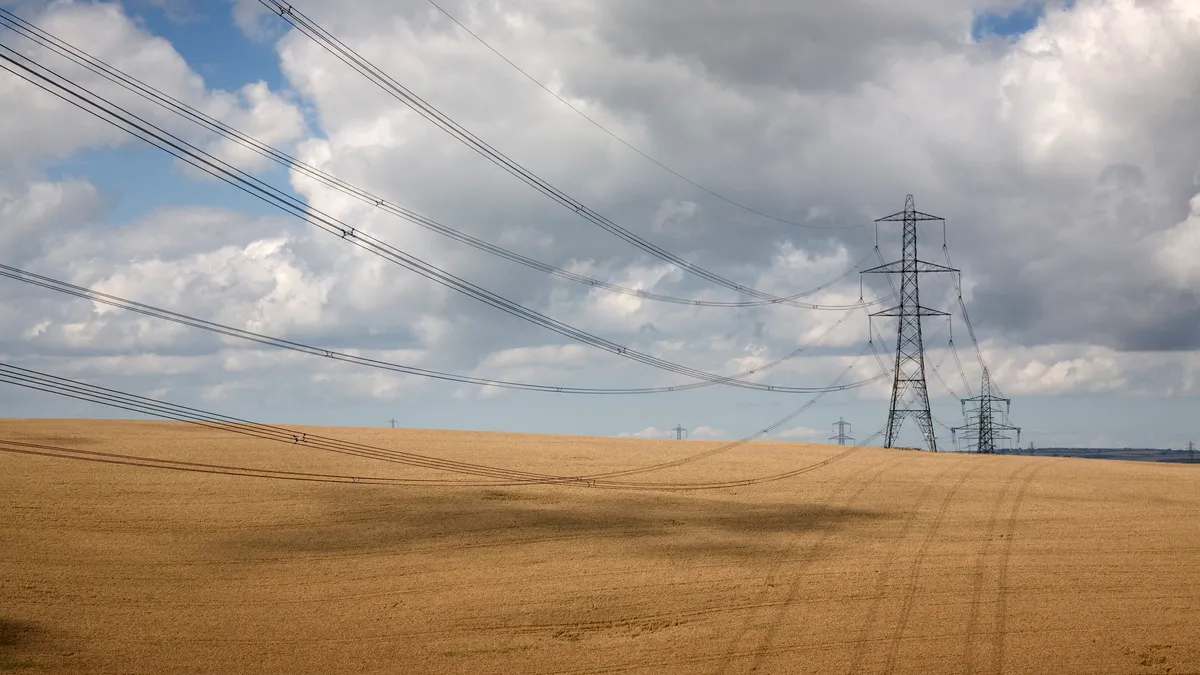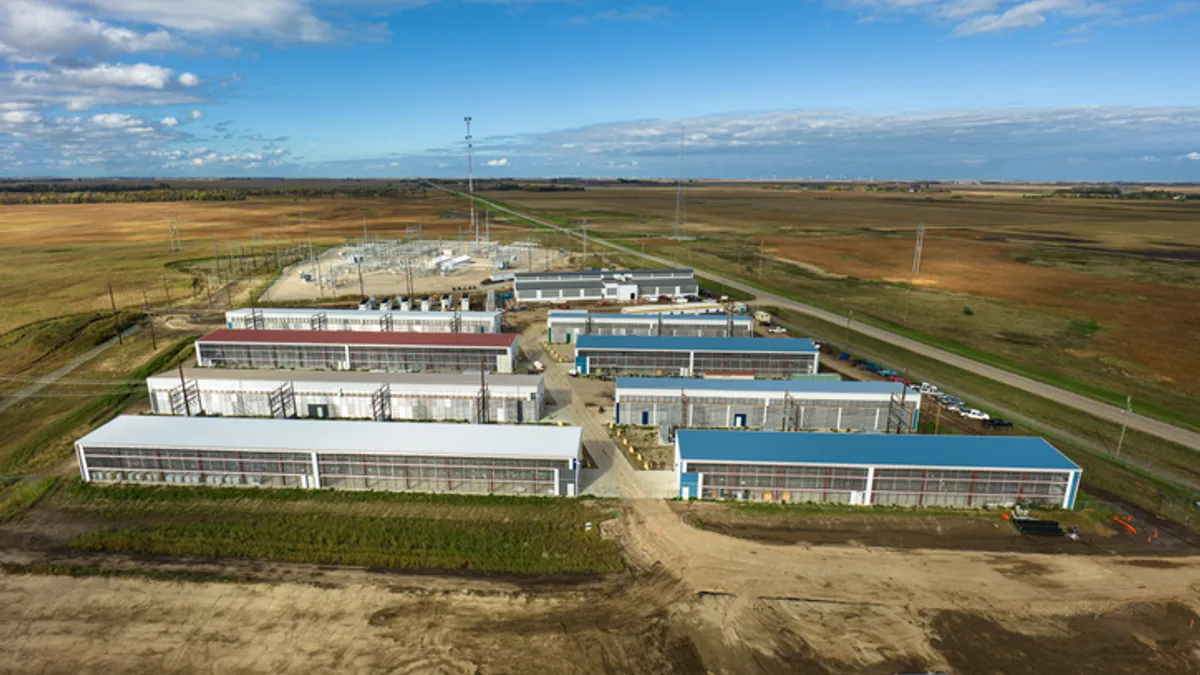The U.S. power system is considered one of the greatest engineering achievement of the 20th century, but it urgently needs a 21st century upgrade.
Electricity consumers pay billions due to congestion and outages, according to the U.S. Energy Department. System operators report that new wires significantly reduce those costs. But transmission and distribution developers are at such odds with one another over who should do the upgrades and how they should be selected that the Federal Energy Regulatory Commission (FERC) may step in.
"New development should be through competitively-bid projects," Brattle Group Principal Judy Chang, co-author of a new study on recent transmission expansions, told Utility Dive. "We documented that competitive solicitations lower customer costs."
"Everyone seems to agree that Order 1000 is not working as intended," but "that's about the only thing stakeholders can agree on."

Neil Chatterjee
Chair, Federal Energy Regulatory Commission
Brattle's study was commissioned and endorsed by LSP Transmission Holdings, a major U.S. transmission owner-developer. Other major U.S. transmission owner-developers object to the study's conclusions.
"FERC's adoption of Order 1000 laid the framework for competition," and American Electric Power (AEP) "was the first utility to create a successful competitive transmission company," AEP spokesperson Tammy Ridout emailed Utility Dive. But Brattle "significantly overstates the cost saving opportunity" from competitive bidding that would go to customers.
"Everyone seems to agree that Order 1000 is not working as intended," but "that's about the only thing stakeholders can agree on," FERC Chair Neil Chatterjee emailed Utility Dive. "We owe it to consumers to put our best effort forward on making competition work," and stakeholders must "come together to address these big issues."
This suggests a new Order 1000 proceeding could be coming. "It is time to open up Order 1000 again," former FERC Chair Jon Wellinghoff, who oversaw the Order's 2011 passage, told Utility Dive.
The need for transmission
Order 1000, issued in July 2011, was intended to expand transmission to help meet the growing demand for renewable generation. It revised rules on transmission planning, on allocating transmission costs and on competitive bidding. New transmission has come online, but 70% of the system is over 25 years old.
Order 1000 was a "well-intentioned attempt" to address "obstacles holding back transmission investment," but it has suffered from "unintended consequences and lackluster implementation," a May study from Grid Strategies Vice President Michael Goggin, who has testified to FERC on Order 1000 issues, reported.
It has been "a mixed success, with less change-making than we hoped for," FERC Commissioner Cheryl LaFleur, who voted for the order in 2011, acknowledged to Utility Dive last year. But "the overwhelming majority of transmission development is not subject to competitive processes, which necessarily limits the savings to customers," she emailed May 22.
A 21st century grid "is even more essential with the growth of technologies such as distributed solar and energy storage" and for "electrification of transportation and building and water heating."

Michael Goggin
Vice President, Grid Strategies
For several of the independent system operators (ISOs) and regional transmission organizations (RTOs) that operate two-thirds of the U.S. power system under FERC governance, recent transmission investments have relieved some congestion, FERC staff reported in October 2017. But Brattle found it is far short of Order 1000's aspirations.
The result is the D+ grade given to U.S. energy infrastructure by the American Society of Civil Engineers, Goggin wrote. But studies and real-world experience show "an investment in transmission will pay for itself many times over."
Transmission expansion could save customers as much as $47 billion annually and reduce electricity bills 10%, according to a study cited by Goggin. A competitive New England system upgrade reduced congestion costs from $600 million annually to under $100 million and the Southwest Power Pool (SPP) concluded "transmission investments provide benefits 2 to 4 times greater than their costs," he added.
A 21st century grid "is even more essential with the growth of technologies such as distributed solar and energy storage" and for "electrification of transportation and building and water heating," Goggin wrote. And renewing the grid requires policies that preserve market efficiencies "by leaving transmission development to the private sector."
Brattle's detailed and thoroughly documented cost analysis asks if Order 1000 did that.
The Brattle Group study
Competitively-developed projects accounted for approximately $540 million, about 3%, of the roughly $20 billion in average annual transmission investment from 2013 to 2017, Brattle calculated.
Researchers found 31 competitively developed projects from ISO/RTO transmission investments in that 5-year period. When construction is complete on the 16 for which adequate data is available, their costs "will be 20% to 30% below costs for projects excluded from competition," Brattle estimated.
Unavailable data qualifies the conclusions and "actual cost savings are expected to be smaller" due to "at least some level of cost escalation," Brattle acknowledged. But savings will still be significant, even if the competitively developed projects have cost escalations comparable to previously built major transmission projects.
But competition motivates developers to find innovative ways to lower initial project estimates and to include contractual cost containment provisions that limit cost escalations, Brattle found. If 33% of projects were competitively developed instead of 3%, and cost savings averaged 25%, "customer value" would be "approximately $8 billion over five years."
Competition-driven cost savings come from "a wide range of innovative approaches to transmission development" in project design, administration and financing, Brattle added.
ISO/RTO rules allowed the other 97% of transmission investments to be excluded from Order 1000 competitive processes, Brattle found.
"[T]he innovation and cost containment in competitive projects and the cost escalations in projects built outside the competitive process shows competition would benefit ratepayers."

Judy Chang
Principal, Brattle Group
Incumbents can claim exclusions for "supplemental" projects that are sited on their rights-of-way, use their infrastructure, are below the voltage threshold or are required for reliability within three years, American Municipal Power (AMP) VP for Transmission Ed Tatum told Utility Dive."Many transmission builders made a conscious business decision not to build competitive generation and to focus on the regulated transmission business," he said.
PJM Interconnect numbers confirmed his point. Supplemental projects averaged 20 per year from 1998 through 2007, according to PJM's 2019 Q1 review. FERC imposed Order 890 in 2007, which led to 2011's Order 1000. From 2008 to 2019, supplemental projects averaged 143 per year, a 615% jump.
Exclusions are necessary, AEP and others said. They know how and when to build and upgrade their transmission systems better than other developers.
"But the innovation and cost containment in competitive projects and the cost escalations in projects built outside the competitive process shows competition would benefit ratepayers," Chang said.
Some incumbents say those numbers are not the whole story.
A problematic process
Several of Brattle's conclusions are based on "incomplete data and misleading analyses," AEP's Ridout said. The study overestimates cost savings because it uses "initial cost estimates rather than the actual cost to develop and construct projects."
Brattle's calculation that only 3% of investments went to competitively bid projects ignores projects that should be included, like competitively bid upgrades, and does not recognize RTO/ITO competitive planning processes, she added. And its findings on cost escalations "are not consistent with AEP's experience" that overall costs for non-competitive projects do not significantly escalate and "come in slightly below the initial cost estimates."
"One of the reasons there have not been many competitive projects is how difficult and expensive the process is."

Nina Plaushin
Vice President of Regulatory and Federal Affairs, ITC Holding Corp
"The competitive process does not necessarily deliver the lowest cost," Xcel Energy spokesperson Wes Reeves agreed by email. "And it can take longer to deliver the critical infrastructure."
FERC was right to use exclusions to "not impose the cost and time of the complex competitive bidding process for projects that are really needed," ITC Holding Corp Vice President for Regulatory and Federal Affairs Nina Plaushin added. "One of the reasons there have not been many competitive projects is how difficult and expensive the process is."
SPP numbers confirm her point. Of the more than $8 million spent on the 11 proposals in SPP's 2015 competitive solicitation, 46% to 59% went to expenses for proposing, evaluating and selecting the project, according to an October 10, 2018, presentation from Nebraska Public Power District (NPPD) VP John C. McClure.
Order 1000 has led to "more process, more compliance, more delay, more paperwork, more planning [and] less transmission actually being built," former FERC Commissioner Tony Clark wrote in an April 2018 white paper that called for the order to be reassessed.
Competitive process costs "are not trivial," Brattle acknowledged. But they are "relatively small compared to the transmission project costs and the potential cost savings." And if transmission is built more cost-effectively through reformed competitive processes, it would become "a more attractive solution" and could bring "diversified resources and load across larger regions."
In defense of competition
Brattle put too much emphasis on lowest cost projects, Xcel's Reeves and ITC's Plaushin told Utility Dive.
But "Brattle found cost savings from winning bids, which are different from the cheapest bids," LSP Transmission VP for Development Sharon Segner responded. "They were projects that met all solicited requirements and had cost savings over non-competitive projects."
The Brattle report shows "what's right and what's wrong with Order 1000," Segner told Utility Dive. "It also shows the limited investment in competitive projects is not what Order 1000 intended. But the problem is not the Order, it is the exclusions granted by FERC in the RTO/ISO compliance filings."
The exclusions allow project development outside the Order 1000 competitive guidelines and, without competition, "developers don't commit to caps on cost overruns," she said. "Those commitments to cost containment lead to real consumer savings. That is the bottom line."
"[I]t was clear in 2011 when we passed Order 1000, and it is still clear, that more competition is good for ratepayers. Brattle's savings estimates are probably conservative."

Jon Wellinghoff
Former FERC Chair
Competition in transmission "is good for the market" and "more competitive forces need to be introduced," Joe Bowring, President of PJM independent market monitor Marketing Analytics, told Utility Dive.
The exclusions should not be "used to exempt transmission projects from a transparent, robust and clearly defined mechanism to permit competition," the market monitor's 2019 Q1 State of the PJM Market Report said. PJM should also evaluate "binding cost containment proposals versus proposals without cost containment," the report added.
However, "there are significant process barriers to competitive transmission development," former FERC Chair Wellinghoff said. "The main barrier is that incumbents are advantaged by being familiar with the region and its regulators and competitive developers from outside the region have difficulty being heard. The process is a problem."
But "it was clear in 2011 when we passed Order 1000, and it is still clear, that more competition is good for ratepayers," he added. "Brattle's savings estimates are probably conservative."
Besides the wide stakeholder agreement that Order 1000 needs to be addressed, as noted by Chatterjee, there is another point of agreement: FERC must act.
What should FERC do?
FERC and the ISOs/RTOs should implement minimum requirements for project cost reporting and tracking standards to make it possible to identify cost trends, Brattle recommended.
Order 1000 "is a tremendously complex issue" without "easy solutions," Commissioner LaFleur, who is leaving FERC this year, told Utility Dive last year. But competition should be expanded because it leads to "significantly lower costs for consumers."
FERC modifications to exclusions in the Order 1000 compliance filings could increase competitive opportunities, AMP's Tatum, Brattle's Chang and LSP's Segner agreed.
"I don't really care who builds the transmission, I just want it built."

Michael Goggin
Vice President, Grid Strategies
AEP's Ridout joined the Brattle study's call for "solution-based" competitive procurement processes. Unlike "cost-based solutions," they drive "innovative and cost-effective solutions" by focusing on a wider range of factors, with cost being only "one of those factors," Ridout said.
ISOs and RTOs need to demand "the least-cost, most reliable solution in transmission planning," Wellinghoff said. And FERC needs to go a step further and open the system with "a mechanism that allows any third-party to interconnect transmission infrastructure that meets system needs."
Finally, several stakeholders told Utility Dive what Grid Strategies' Goggin said best. "I don't really care who builds the transmission, I just want it built." Goggin and the others did not specify FERC action, but Chair Chatterjee seems to know what must come next.






















